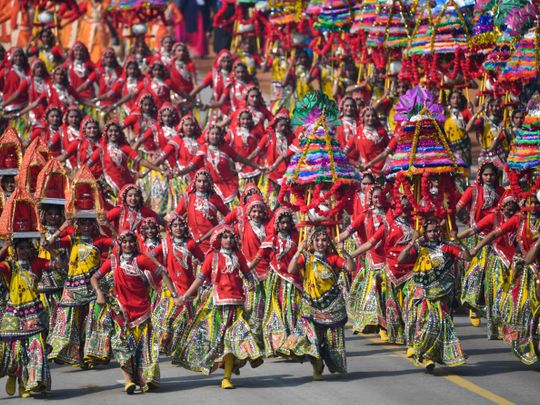
With a majestic parade on Rajpath or the King’s Way in the capital and vibrant pageantry around the country, the Indian republic turned 71 on January 26.
This is the day in 1950 when the Indian Constitution came into effect, replacing the British-era Government of India Act as the governing document for the newly-independent country.
The grandeur of Republic Day celebrations were as fascinating as their diversity. The parade in New Delhi saw states display their unique heritage — from Dussehra festival by Himachal Pradesh and Bathukamma from Telangana to the ‘Back to Village’ tableau of Jammu and Kashmir and traditional Garba dancers from Gujarat. Women were at the forefront too, with Captain Tania Shergill leading an otherwise all-male military contingent at the parade. In Kerala, the tricolour was unfurled at more than 10,000 mosques and religious institutions across the South Indian state. And Google weighed in with a digital salute to the Indian republic, dedicating a doodle illustrating the country’s rich cultural heritage. Indian diaspora also celebrated around the world — including in colourful ceremonies in the UAE.
Governments at federal and state levels must uphold the secular and democratic tenets of the constitution — but that’s a responsibility that must also be shared by its people and independent institutions such as the judiciary.
The diversity of celebrations drive home the splendour of India’s democratic fabric and its plurality, as framed by its constitution — and that’s one of the fundamental strengths that has enabled India to flourish as the world’s largest democracy and an economic powerhouse.
As mentioned in its preamble, the founding fathers of India adopted a liberal and secular constitution which enshrines fundamental rights, guarantees basic institutions to people and creates institutional checks and balances. The underlying spirit of India as a constitutional democracy is one of engaging citizens to create a community of equals that leads to social and economic uplift. It’s hardly a wonder that the idea of the Indian Republic in 1950 was dubbed the biggest liberal experiment in democratic governance — and has often come under withering assault from a variety of constituents and undergone several changes.
Republic Day is therefore not only an occasion to celebrate but also reflect on the great responsibility that comes with such a milestone — the responsibility to preserve, protect and defend the values enshrined in the Indian Constitution.
Governments at federal and state levels must uphold the secular and democratic tenets of the constitution — but that’s a responsibility that must also be shared by its people and independent institutions such as the judiciary.
A balance of rights and duties practised by all partners in this journey will ensure that the Indian Republic remains robust, resilient and true to the ideals of its constitution.








